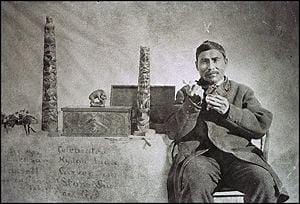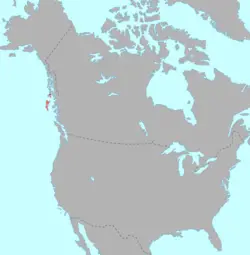Haida
| Haida |
|---|

|
| Total population |
| c. 2,000 [1] |
| Regions with significant populations |
| Canada (British Columbia), United States (Alaska) |
| Languages |
| English, Haida |
| Religions |
The Haida are an indigenous people of the west coast of North America. The Haida Nation claimed territories comprise an archipelago called the Queen Charlotte Islands or Haida Gwaii as the Haida refer to the islands - and parts of southeast Alaska. The Haida are commonly referred to in Canada as being a First Nations "band" or a "tribe" in the parlance of the United States. Their ancestral language is the Haida language, which is now extremely endangered.
The Central Council of the Tlingit and Haida Indian Tribes of Alaska represents 26,000 members as a sovereign nation. Their battle for human rights in the past century became the grounds for the unity between the two tribal groups. The Haida in Canada created the Council of the Haida nation gaining back autonomy from the Canadian Department of Indian Affairs in the 1980s.
The Haida are renowned craftsmen in wood and copper. Totem poles depicting respected mythical creatures are common symbols associated with their heritage. Their clan totems fall under the Raven or Eagle.
Culture
The Haida people are well known as skilled artisans of wood, metal and design. They have also shown much perseverance and resolve in the area of forest conservation. These vast forests where the Haida make their homes are pre-glacial and are believed to be almost 14,000 years old. Haida communities located in Prince of Wales Island, Alaska, and the Queen Charlotte Islands also share a common border with other indigenous peoples such as the Tlingit and the Cape Fox tribes of the Tsimshian.
The Tlingit called the Haida Deikeenaa, "far out to sea people", from the distance separating Haida Gwaii from the mainland and the Alexander Archipelago.
Although Haida societal structure is a living process, its roots are in the ancient potlatch system, and remain recognizable in contemporary political, economic and legal functions. On that portion of Haida territory claimed by Canada, the two communities of Massett and Skidegate have Band Councils that experience varying degrees of influence and control by Canada's federal government. The persistence of Haida government can be seen in that the influence of the Band Councils, insofar as they may be seen as agents of Canadian government authority, are regulated by a community governance system of Matriarchs and Lineage authorities.
Haidas were traditionally known as fierce warriors and slave-traders, raiding as far as California. Haida oral narratives record journeys as far north as the Bering Sea, and one account implies that even Asia was visited by Haidas before Europeans entered the Pacific. The Haida ability to travel was dependent upon a supply of ancient Western Redcedar trees that they carved into their famous Pacific Northwest Canoes. Carved from a single redcedar tree, a vessel could sleep 15 adults head to toe, and was propelled by up to 60 paddlers (who often included women). In the event of a battle at sea, paddlers were armed with heavy stone rings (18 to 23 kg) attached to woven tree root or bark ropes. These devices, when thrown at enemy canoes, inflicted substantial damage. Haida warriors entered battle with redcedar armor, wooden shields, stone maces and atlatls. War helmets were elaborately carved, and armor was made or reinforced with metal, stone, bone or copper.
The Haida were hunters and gatherers. Because they lived so near the sea, fishing was crucial to them. Salmon was a main source of food, which was filleted & smoked to keep through the winter. The skeleton of the first salmon caught in a season was always placed back where it was caught. This was an offering, so the Salmon would return the following season.
Like all indigenous peoples of the northeast coast of the Pacific Ocean, the Haida make extensive use of redcedar bark, which is still used both as a textile for clothing, ropes and sails, and in its raw form, as a building material or even armor. Most goods were fashioned from the wood of the Western Redcedar, Nootka Cypress, Western Hemlock and Sitka Spruce. Highly prized plant bark and root weavers still create an array of clothing including hats and containers. The ancient Naahinn form of weaving — also called Chilkat — continues, although commercially produced wool is used instead of mountain goat. The famous Haida totem poles were also carved on the trunks of Red Cedar trees.
In ancient times, valuable items were also fashioned from copper. Haida culture places high value on a sophisticated and abstract iconic art form. Although most impressively expressed in large monumental totem poles, this highly disciplined design is applied to a wide range of materials, including the human body through tattooing. The diversity of Haida design can be seen in its expression as Haida Manga.
Social Structure
The Haida theory of social structure is based on moiety lineages. That is, the society is divided into two groupings, one called Raven and the other Eagle. There are a variety of subgroups that fall into either of the moieties. The moieties and their subgroups of Clans, or matrilineal lineages, own unique combinations of crests and other intellectual properties such as songs and names. People cannot marry a member of their own moiety. Potlatches, ceremonies to show wealth or to earn status in a community, were closely linked to a man's moiety. Potlatches would have been a huge celebration, hosted by a wealthy member of the community. A host would have invited hundreds of guests. Guests would have come in best dress and in best canoes, ready for up to 10 days of feasting. Afterwards, all the host's possessions were distributed to guests. However, this would not have bankrupted a host, as they could always rely on getting gifts from a neighbours potlatch, if theirs was up to standard.
Art and Mythology
The artwork of the Haida is often associated with the traditional totem pole. The art is also reflected on family crests and pictoral panels. Two contrasting colors, such as red and black, are used to depict solid and empty space. Common figures are animals, birds, sea creatures, and mythic creatures that identify the moiety of Raven or Eagle. The Killer Whale is associated with the Raven lineages, for example, as are the Grizzly and Wolf. Amphibious creatures such as Frog and Beaver as well as a variety of fish are also associated with this lineage. The Raven group does not use its name sake as a symbol or most other birds in general. The Eagle group does identify with birds.
Raven is the central character for tribes or bands found in central and northern coasts of Canada and Alaska. He is a trickster and stories are based on his exploits such as freeing humankind from a clam shell. He is a paradoxical figure as his mischievous, greedy, and cruel intentions almost always teach something valuable to the humans that he is working against. Cite error: Closing </ref> missing for <ref> tag.
As for the Haida Nation in Canada, the 2004 Supreme Court of Canada in Haida Nation v. British Columbia (Minister of Forests), [2004] 3 S.C.R. 511 declared that the Crown had a legal duty to consult with the Haida Nation and accommodate their interests when issuing a timber license to a forestry company for harvesting wood on lands claimed by the Haida Nation. This decision is made in view of the Court's famous 1997 decision of Delgamuukw v. British Columbia, [1997] 3 S.C.R. 1010 where the Court had established the legal precedent that a First Nations band in Canada can make claim to "Aboriginal title" to specific land, despite Crown sovereignty over all lands in Canada, if they had occupied such land prior to the Crown asserting its sovereignty over this land and if the specific land itself is integral to the First Nations band's distinctive culture. The concept of "Aboriginal title" extends beyond the mere right to use (e.g. to hunt and fish on) specific lands, but it is different from typical private land ownership in that "Aboriginal title" is a communal right linked to indigenious culture.
Notes
- ↑ Thunderbird Park – A Place of Cultural Sharing. Royal British Columbia Museum. Retrieved 2006-06-24. "Haida Pole, 1954. Carvers: Mungo Martin, David Martin and Henry Hunt. Based on: Haida Memorial Pole. This is a version of a pole that was purchased by Charles F. Newcombe at t'anuu 'llnagaay (eelgrass town) in 1911. It was raised by a man named Checkgath around 1880 as a memorial to his wife and shows some of Checkgath's family crests. The original pole is now in the entrance lobby of the museum."
Books
- A Story as Sharp as a Knife: The Classical Haida Mythtellers and Their World, Robert Bringhurst, Douglas & McIntyre August 2000
Credits
New World Encyclopedia writers and editors rewrote and completed the Wikipedia article in accordance with New World Encyclopedia standards. This article abides by terms of the Creative Commons CC-by-sa 3.0 License (CC-by-sa), which may be used and disseminated with proper attribution. Credit is due under the terms of this license that can reference both the New World Encyclopedia contributors and the selfless volunteer contributors of the Wikimedia Foundation. To cite this article click here for a list of acceptable citing formats.The history of earlier contributions by wikipedians is accessible to researchers here:
The history of this article since it was imported to New World Encyclopedia:
Note: Some restrictions may apply to use of individual images which are separately licensed.
